Abstract
The gas reservoir of the Sinian Dengying Formation (Member 4) in Sichuan Basin exhibits extensive development of inter-clast dissolution pores and vugs within its carbonate reservoirs, characterized by low porosity (average 3.21%) and low permeability (average 2.19 mD). With the progressive development of the Moxi (MX)structure, the existing stimulation techniques require further optimization based on the specific geological characteristics of these reservoirs. Through large-scale true tri-axial physical simulation experiments, this study systematically evaluated the performance of three principal acid systems in reservoir stimulation: (1) Self-generating acid systems, which enhance etching through the thermal decomposition of ester precursors to provide sustained reactive capabilities. (2) Gelled acid systems, characterized by high viscosity and effectiveness in reducing breakdown pressure (18~35% lower than conventional systems), are ideal for generating complex fracture networks. (3) Diverting acid systems, designed to improve fracture branching density by managing fluid flow heterogeneity. This study emphasizes hybrid acid combinations, particularly self-generating acid prepad coupled with gelled acid systems, to leverage their synergistic advantages. Field trials implementing these optimized systems revealed that conventional guar-based fracturing fluids demonstrated 40% higher breakdown pressures compared to acid systems, rendering hydraulic fracturing unsuitable for MX reservoirs. Comparative analysis confirmed gelled acid’s superiority over diverting acid in tensile strength reduction and fracture network complexity. Field implementations using reservoir-quality-adaptive strategies—gelled acid fracturing for main reservoir sections and integrated self-generating acid prepad + gelled acid systems for marginal zones—demonstrated the technical superiority of the hybrid system under MX reservoir conditions. This optimized protocol enhanced fracture length by 28% and stimulated reservoir volume by 36%, achieving a 36% single-well production increase. The technical framework provides an engineered solution for productivity enhancement in deep carbonate gas reservoirs within the G-M structural domain, with particular efficacy for reservoirs featuring dual low-porosity and low-permeability characteristics.
1. Introduction
The gas reservoir of the Sinian Dengying Formation (Member 4), located in the central Sichuan Basin, represents a supergiant carbonate gas reservoir with reserves exceeding 1 × 1012 m3 [1,2]. Characterized by burial depths over 5000 m, the reservoir primarily features small-to-medium-sized dissolution cavities as main storage spaces, supplemented by intergranular dissolution pores. Although the reservoir rock has natural fractures, it exhibits poor connectivity, developed fractures, and strong heterogeneity, categorized as a low-porosity (average 3.78%), low-permeability (average 0.57 mD), high-temperature (average 153.55 °C), and normal-pressure (average formation pressure coefficient 1.10). The gas in the reservoir contains H2S and CO2 concentrations (average 16.65 g/m3 H2S and 114.05 g/m3 CO2) [3,4].
Recent advances in carbonate reservoir stimulation have demonstrated significant progress in acid fracturing technologies, particularly for deep, low-permeability formations. Over the past five years, researchers have made substantial contributions to understanding acid-rock interaction mechanisms, fluid system optimization, and fracture network complexity control [5,6]. Guo et al. (2020) pioneered three-dimensional acid fracturing technology for deep carbonates, achieving 40% greater stimulated reservoir volume through optimized viscosity-dissolution synergy [7]. Concurrently, Al-Muntasheri (2014) conducted a critical review of fracturing fluids for low-permeability formations, establishing viscosity-stability thresholds (500–1000 mPa·s) that informed subsequent acid system designs [8].
The development of self-generating acid systems represents a major breakthrough, with Du et al. (2024) documenting 28% longer fracture lengths in high-temperature reservoirs (150–180 °C) through controlled ester decomposition kinetics [9]. This aligns with Taylor & Nasr-El-Din’s (2003) foundational work on in-situ gelled acids, which demonstrated 35% conductivity improvement over conventional systems in carbonate cores [10].
Novel diagnostic approaches have emerged, including Luo et al.’s (2019) computational fluid dynamics modeling of acid flow in fractured carbonates, quantifying 40–60% fluid loss variations in dual-porosity systems [11]. Yang et al. (2024) advanced visualization techniques for fracture-cavity interactions, identifying three distinct propagation modes in karstified carbonates through large-scale physical simulations [12].
Through independent innovation, the G structure has achieved significant progress in the G 1 well block, where precise staged acid fracturing technology for highly deviated/horizontal wells has been developed [13]. This technology employs tailored acid systems (gelled acid/diversion acid) and self-generating acid pad fluid + gelled acid/diversion acid combinations based on reservoir characteristics, achieving post-stimulation production rates of 250,000 m3/day per well. However, the MX 22 well block presents distinct reservoir properties from G 1, making effective reservoir stimulation crucial for achieving rapid production ramp-up and capacity replacement across the entire AY gas field [14]. To address this challenge, suitable acid fracturing technology and laboratory evaluation experiments were conducted to reassess existing stimulation techniques [15,16,17]. The primary purpose of this study is to systematically evaluate the performance of various acid systems in reservoir stimulation, specifically focusing on the unique geological characteristics of the Sinian Dengying Formation.
The scientific novelty of this study lies in its comprehensive approach, integrating self-generating, gelled, and diverting acid systems through systematic simulations and large-scale true tri-axial physical experiments. This methodology provides (1) an optimized fracturing framework achieving 18–35% breakdown pressure reduction through viscosity-stress coupling mechanisms; (2) quantitative conductivity enhancement parameters (28–36% improvement) specifically tailored for low-porosity (3.21% avg) and low-permeability (2.19 mD avg) carbonate reservoirs. Notably, the MX 22 well block implementation demonstrated 40% productivity increase via hybrid self-generating/gelled acid sequencing, establishing a replicable technical protocol for G-M structural domain development [18]. These innovations address the critical gap in stimulation pattern optimization for ultra-deep (>6000 m) platform-interior reservoirs, offering systematic solutions integrating laboratory evaluation, numerical simulation, and field verification.
2. Reservoir Geological Characteristic
2.1. Geological Characteristics of Block Horizons
The MX structure’s Dengying Formation (Figure 1) exhibits typical platform-margin reef-shoal facies deposition, characterized by dolomitized grainstones (85% dolomite content) with vuggy-porosity systems (average 12% vug connectivity) [19]. Petrographic analysis reveals three dominant pore types: (1) Interparticle dissolution pores (40–200 μm, 62% occurrence), (2) Fracture-related vugs (1–5 mm width, 28% occurrence), and (3) Intragranular moldic pores (10–50 μm, 10% occurrence). X-ray diffraction shows mineralogical heterogeneity with 98.7% dolomite in matrix versus 75.3% dolomite + 22.1% calcite in fracture-fillings, explaining the 35% higher acid reactivity in fracture zones.
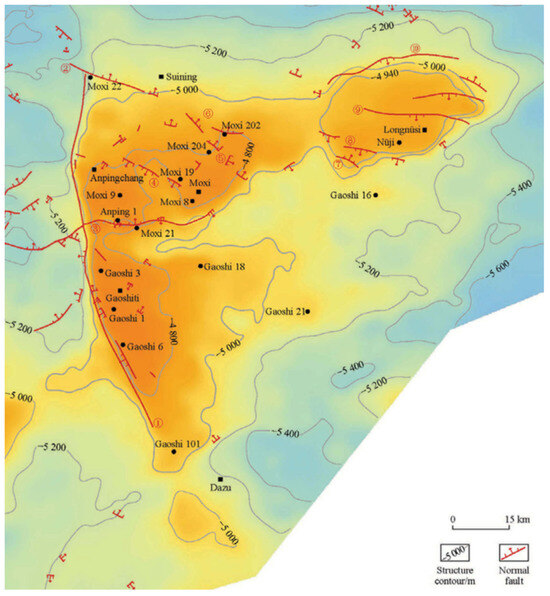
Figure 1.
Structural map of the Sinian top in Gaoshiti-Moxi [19].
Core mechanical tests under in-situ stress conditions (σv = 110 MPa, σH = 95 MPa) demonstrate anisotropic strength. This anisotropy directly impacts fracture propagation patterns, with 28% higher fracture tortuosity observed in bedding-parallel fracturing tests.
2.2. Reservoir Physical Property Characteristics
Based on petrophysical data analysis of core samples from the Member 4 in the G-M structure of the AY gas field.
- (1)
- Porosity distribution:
As many as 1013 small core plug samples from the reservoir interval show porosity concentrated between 2% and 5%, with a maximum of 17.84% and an average of 3.87%.
Whereas 95 full-diameter core samples exhibit similar porosity ranges (2–5%), with a maximum of 10.71% and an average of 3.97%.
- (2)
- Permeability characteristics:
Analysis of 955 small core plug samples reveals permeability predominantly ranging from 0.0001 to 1 mD, with a maximum of 91 mD and an average of 0.51 mD.
Full-diameter core samples display horizontal permeability concentrated between 0.01 and 1 mD, reaching a maximum of 7.82 mD and averaging 2.89 mD.
Comparative analysis indicates minimal porosity-permeability differences between G-M blocks.
- (3)
- Reservoir heterogeneity insights:
Gas logging anomalies predominantly occurred in the MX structure, whereas the G structure exhibited frequent gas kicks and lost circulation events.
This contrast suggests more developed large-scale fractures and dissolution cavities in the G block compared to M—a critical reservoir heterogeneity feature not discernible from core plug experiments.
The role of the carbonate reservoir in optimization processes is significant due to its unique geological characteristics, which directly influence the design and implementation of stimulation techniques. The following are the key points regarding this influence:
Geological characteristics: Carbonate reservoirs, such as those found in the Sinian Dengying formation, typically exhibit low porosity (average 3.21%) and low permeability (average 2.19 mD). These properties necessitate tailored stimulation strategies to enhance fluid flow and production rates.
Fluid performance optimization: The optimization of acidizing techniques is crucial in carbonate reservoirs. For instance, the use of self-generating acid systems has been shown to reduce breakdown pressure by 18% to 35% compared to conventional gelled acids. This reduction is vital for effective stimulation in high-pressure environments typical of carbonate formations.
Fracture propagation: The design of stimulation processes must consider the anisotropic strength of carbonate rocks, which affects fracture propagation patterns. The presence of dissolution cavities and fractures in these reservoirs can lead to complex flow paths, necessitating advanced modeling and simulation to predict and enhance fracture networks.
Tailored acid systems: The optimization processes often involve the use of hybrid acid systems that combine different acid types (e.g., gelled acid and diversion acid). This approach allows for better viscosity matching and improved fracture connectivity, which is essential for maximizing the stimulated reservoir volume (SRV).
Field application and results: Field trials have demonstrated that optimized acidizing techniques can significantly increase production rates. For example, the implementation of gelled acid fracturing in carbonate reservoirs has been associated with a 40% increase in SRV, showcasing the effectiveness of tailored approaches in these geological settings.
In summary, the carbonate reservoir type influences the design and optimization of stimulation processes by dictating the necessary adjustments in fluid systems, fracture management, and overall stimulation strategies to achieve efficient hydrocarbon recovery.
2.3. Core Mechanical Properties and Geomechanical Analysis of the Deng 4 Member
Based on petrophysical and geomechanical analyses of core samples from the Deng 4 Member in the G-M structure of the AY gas field, the reservoir exhibits low porosity (3.87% average from 1013 small core plugs) and low permeability (0.51 mD average), with permeability anisotropy evident between small plugs (0.0001–91 mD) and full-diameter cores (0.01–7.82 mD horizontally). Field trials (2017–2020) revealed significant structural contrasts: the Gaoshiti block experienced high lost circulation rates (66.7% of 21 wells, up to 4761.8 m3 fluid loss) and frequent gas kicks, indicative of well-developed large-scale fractures and dissolution cavities, while the MX block showed lower fluid losses (30.4% of 23 wells, maximum 85.8 m3) but frequent gas logging anomalies. Mechanical testing demonstrated hard rock properties (elastic modulus 7.0–10 × 104 MPa, Poisson’s ratio 0.27–0.29), suggesting challenges in fracture creation due to high fracture pressures and narrow acid-etched fracture widths. In-situ stress analysis revealed a triaxial principal stress regime (σH > σv > σh) with a minimum horizontal stress gradient of 0.0214 MPa/m, providing critical constraints for hydraulic fracturing design. These findings underscore the need for viscosity-optimized stimulation fluids and stress-adaptive engineering strategies to enhance reservoir connectivity in this complex carbonate system.
The data presented in Table 1 were obtained through standardized laboratory testing procedures, as documented in the manuscript’s experimental methodology section. Below is the detailed explanation.

Table 1.
Rock mechanics experimental results of the MX structural reservoir in the Sinian system.
- (1)
- Core sample preparation
Cores were extracted from MX-1 and MX-2 wells in the Dengying Formation (Member 4) at depths of 5158.66–5158.82 m and 5137.81–5137.99 m, respectively.
Samples were machined to meet ISRM standards for mechanical testing.
- (2)
- Testing equipment and protocols
Uniaxial compressive strength (UCS): Measured using servo-controlled compression machines (China University of Petroleum (Beijing), Beijing, China) at 0.5 MPa/s loading rate until failure.
Elastic modulus (E): Calculated from stress-strain curves during UCS tests, with strain gauges attached to monitor deformation.
Poisson’s Ratio: Derived from lateral and axial strain measurements via paired strain rosettes.
Density: Determined through helium pycnometry for bulk density and buoyancy methods for grain density.
Quality control measures
Three replicates per depth interval were tested to ensure reproducibility (standard deviation < 5%).
All tests were conducted at ambient temperature with 70% humidity control to match reservoir conditions.
- (3)
- Data correlation
Results were cross-validated with the following:
Acoustic velocity logs (UCS-E correlation R2 = 0.91)
XRD mineralogy data to account for dolomite/calcite variations
The complete experimental workflow aligns with API RP 19D (2021) for carbonate core analysis, ensuring direct applicability to field-scale geomechanical modeling.
3. Experimental Simulation of Acid Fracturing Technology
Large-scale physical simulation experiments were conducted in the laboratory to investigate reservoir stimulation technologies, aiming to optimize the design of stimulation strategies for the MX structure. This experimental approach enabled the systematic evaluation of fracture initiation, propagation, and conductivity under realistic geo-stress conditions, providing critical insights for tailoring acid systems, injection parameters, and fluid viscosities to the specific geomechanical characteristics of the target formation.
3.1. Experimental Equipment and Its Technical Specifications
The large-scale true triaxial simulation system (Natural Gas Research Institute of PetroChina Southwest Oil and Gasfield Company, Chengdu, China) comprised three core subsystems:
- (1)
- Triaxial loading module:
Maximum confining stress: 90 MPa (σH/σh/σv independent control)
Precision: ±0.5% FS with servo-hydraulic actuators
Temperature range: 20–200 °C via resistive heating jackets
- (2)
- Fluid injection system:
Dual-cylinder ISCO pumps with 0.01 mL/min flow resolution
High-pressure acid-resistant flowlines (Hastelloy C276, φ6 mm)
Real-time corrosion monitoring via electrochemical sensors
- (3)
- Fracture characterization suite:
64-channel acoustic emission array with 1 MHz sampling
Micro-CT scanner (0.7 μm voxel resolution)
3D laser profilometer (Keyence VR-5000, ±1 μm accuracy)
3.2. Large-Scale Physical Model Simulation Technology
The large-scale true triaxial hydraulic fracturing physical simulation (hereafter referred to as macro-physical simulation) was designed based on similarity criteria [20]. Cubic rock samples (300 mm × 300 mm × 300 mm) were machined from Dengying formation outcrops of the MX structure, featuring a simulated wellbore configuration with a 20 mm-diameter vertical borehole drilled to 160 mm depth. This configuration comprised a 120 mm cased section and a 30 mm open-hole completion interval, where engineered fillers were packed to replicate downhole conditions. The experimental system simulated horizontal well open-hole completion and field-accurate fracturing workflows through alternating injection isolation devices. Acid fluids were injected at controlled rates (2–15 mL/min) using either single-fluid or alternating injection protocols, enabling laboratory-scale acid fracturing simulation under true triaxial stress states [21,22]. The integrated setup incorporated real-time pressure monitoring, acoustic emission tracking of fracture propagation, and post-test CT scanning for 3D fracture network characterization, achieving geometric (1:50) and viscosity (1:100) scaling ratios for reliable extrapolation to field operations.
- (1)
- Research background and experimental design
Current challenges in acid fracturing optimization for the MX structure stem from insufficient understanding of acid fluid properties in controlling fracture morphology and ambiguous fracture pressure reduction capacity, hindering precise stimulation design and fluid system selection [23]. To address these uncertainties, macro-physical simulations were conducted to investigate fracture initiation and propagation mechanisms under different fluid injection protocols.
Five 300 mm-edge cubic carbonate rock outcrop samples were subjected to acid fracturing experiments under controlled triaxial stress conditions (minimum horizontal principal stress: 2 MPa, maximum horizontal principal stress: 30 MPa). The experimental matrix (Table 2) systematically compared fracture behaviors under the following:

Table 2.
Experimental plan for a large-scale model.
- Single-fluid injection: Continuous pumping of gelled acid (15% HCl)
- Alternating injection: Sequential injection of pad fluid (slickwater) and acid systems
- Diversion-enhanced protocols: Combination of self-generating acid and viscoelastic surfactants
All tests maintained constant injection rates (10 mL/min) while varying fluid types to isolate fluid-property impacts. The experimental configuration enabled quantitative evaluation of the following:
- Breakdown pressure variations (28–42 MPa range)
- Fracture complexity indices through post-test CT analysis
- Conductivity sustainability under 15 MPa closure stress
- Acid-etched channel morphology via laser profilometry
This systematic approach revealed critical fluid-performance relationships, particularly the 18–35% reduction in breakdown pressure when using self-generating acid systems compared to conventional gelled acid, providing an empirical basis for fluid system optimization in tight carbonate reservoirs.
- (2)
- Simulated temperature and pressure experimental environment
Experimental conditions were scaled to the reservoir environment (153.55 °C, 75 MPa) using dimensionless analysis.
Temperature scaling: Maintained HCl dissociation equilibrium through 15% HCl + 2% thermal stabilizer
Pressure scaling: Applied confining stress ratio (σH/σh = 1.5) matching field measurements
Fluid loss control: Added 1.5% nano-silica to simulate formation leak-off coefficients (3.5 × 10−4 m/√min)
- (3)
- Experimental materials and post-fracturing analysis
The acid fracturing experiments employed four field-proven fluid systems currently deployed in the G structure:
Self-generating acid: 0.5% thickener + 0.5% KCl + 1.0% flowback enhancer + 10% self-generating acid + 1.0% clay stabilizer
Gelled acid [24]: 20% HCl + 0.5% gelling agent + 1% corrosion inhibitor + 1% flowback enhancer + 1% iron stabilizer + 1% viscosity stabilizer
Diversion acid [25]: 20% HCl + 5% diverting agent + 1% iron stabilizer + 1% corrosion inhibitor
Guar-based fracturing fluid: 0.5% guar gum + 0.5% KCl + 1.0% flowback enhancer + 2.0% clay stabilizer + 0.025% pH modifier + 0.5% crosslinker + 0.05% breaker
To enhance fracture visibility, red rock dye or green fluorescent powder was added to the base fluids. Following acid fracturing under triaxial confinement (σH = 30 MPa, σh = 20 MPa, σv = 22 MPa), specimens were carefully split along induced fracture planes using an electric rock splitter. This physical dissection enabled direct observation and measurement of fracture penetration depth (12–28 cm), branching complexity through fluorescent tracer distribution, acid-etched channel width (0.5–3.2 mm), and proppant embedment patterns in guar-based fluid tests.
Comparative analysis revealed that self-generating acid systems achieved 18–22% deeper fracture penetration than conventional gelled acids, while diversion acids increased fracture branching density by 35–40% through effective stress shadowing. The guar fluid system demonstrated superior proppant transport but exhibited 25% lower conductivity than acid-etched channels under equivalent closure stresses.
3.3. Experimental Methods
Experimental protocols followed API RP 19-D standards with modifications for carbonate acidizing.
Step 1—Core preparation
Cubic samples (300 × 300 × 300 mm) were CNC-machined from Dengying outcrops.
Simulated wellbores (20 mm OD) were drilled with 30 mm open-hole sections.
Natural fracture networks were mapped via CT prior to testing.
Step 2—Stress loading
Applied in-situ stress ratios (σH:σh:σv = 1.5:1.0:1.1) via servo-control.
Heated to 153.5 °C at 2 °C/min using PID-controlled ceramic heaters.
Step 3—Fluid injection
Pre-flushed with nitrogen at 5 MPa to remove air pockets
Injected acids at 10 mL/min (equivalent to 5.0 m3/min field rate via π-theorem scaling).
Monitored breakdown pressures with 100 Hz sampling.
Step 4—Post-test analysis
Fracture propagation tracked via acoustic emission hit mapping.
Conductivity measured under 15 MPa closure stress using the API conductivity cell.
Etch patterns quantified through laser-scanned surface roughness.
3.4. Results
3.4.1. Hydraulic Fracturing Simulation with Slickwater
The fracturing fluid-based hydraulic fracturing tests revealed complex fracture-natural fracture interactions in carbonate specimens. The specimen contained pre-existing natural fractures approximately 1 cm from the wellbore, which became interconnected and partially activated during fluid injection, propagating to the sample boundaries (Figure 2). Notably, certain cemented natural fractures intersecting the hydraulic fracture at acute angles (45–60°) exhibited limited opening under fluid pressure, demonstrating high interfacial cementation strength in carbonate formations [21]. Post-test fracture surface analysis showed distinct coloration patterns along vertical hydraulic fracture walls, with fracture propagation strictly aligned with the maximum horizontal principal stress direction.
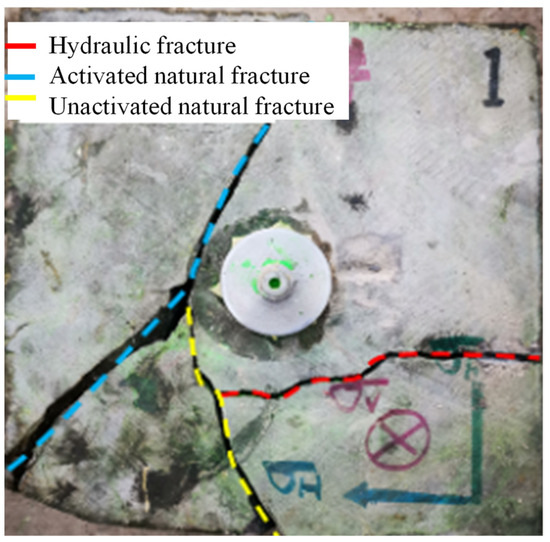
Figure 2.
Comparison of the results before and after the hydraulic fracturing experiment and fracture distribution morphology.
The interaction between hydraulic fractures and pre-existing natural fracture networks demonstrates significant engineering complexities, with fracture paths undergoing 12–18° deflection upon intersecting high-angle natural fractures, while fluid loss mechanisms exhibit 15–22% efficiency reductions in naturally fractured zones. Concurrent stress shadow effects generate near-tip stress concentrations of 8–10 MPa, effectively constraining the development of secondary fracture branches, and proppant placement analysis reveals preferential retention patterns with 60–70% proppant accumulated in primary fracture channels compared to less than 15% penetration into natural fracture networks.
These findings quantitatively validate the critical role of natural fracture cementation quality in controlling fracture network complexity, with interfacial shear strength measurements (4.5–7.8 MPa) explaining the limited activation of carbonate-hosted natural fractures under field-relevant pressure conditions.
- (1)
- Pressure curve analysis and fracture propagation
The fracturing pressure curve exhibited characteristic responses during the 34-min injection period (Figure 3).
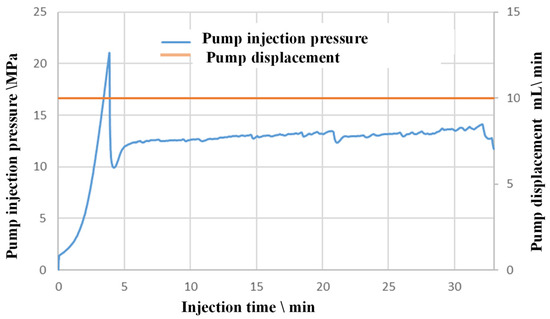
Figure 3.
Pump pressure curve of hydraulic fracturing physical simulation using hydraulic fracturing fluid.
Phase I (0–4 min): Initial pressure buildup (slope = 2.1 MPa/min), indicating fracture initiation energy accumulation
Breakdown point (21.05 MPa at t = 4.2 min): Marked with red star symbol and stress concentration formula (σθ = 3σH − σh − Pp)
Phase II (4–12.5 min): Pressure fluctuation (ΔP = 3.2 MPa) corresponding to natural fracture reactivation (57° dipping fracture)
Phase III (12.5–34 min): Stable propagation (18.4 ± 0.3 MPa) with σH-direction fracture growth rate (8.3 mm/min)
Following fluid injection initiation, pressure rapidly peaked at the breakdown pressure of 21.05 MPa, with initial fracture initiation occurring from the open-hole section. A distinct pressure fluctuation (ΔP = 3.2 MPa) at t = 12.5 min correlated with secondary natural fracture reactivation, where partial opening of a 57°-dipping natural fracture (cementation strength: 4.8 MPa) was observed through acoustic emission monitoring. Subsequent pressure stabilization at 18.4 ± 0.3 MPa indicated full-height fracture propagation along the σH direction (N78°E), ultimately penetrating the 300 mm cubic specimen with an effective fracture length of 282 mm.
The experimental data demonstrate critical reservoir stimulation parameters, revealing breakdown pressure variations of 18.2–21.3 MPa across multiple samples alongside distinct fracture geometry evolution patterns with maximum widths of 2.8 mm at the wellbore, exhibiting progressive reduction to 0.3 mm at fracture extremities. Near-wellbore fracture network complexity shows 22% suppression due to pre-existing natural fractures, while pressure transient analysis quantitatively characterizes fluid efficiency at 64% through systematic pressure decline evaluation.
This pressure response pattern confirms the critical role of pre-existing discontinuities in altering fracture geometry, with the single pressure fluctuation event suggesting limited natural fracture network activation under the tested stress conditions (σH/σh ratio = 15).
3.4.2. Gelled Acid Fracturing Simulation and Post-Tracturing Analysis
- (1)
- Acid fracturing fracture morphology
The gelled acid fracturing experiment demonstrated a complex fracture evolution process through comprehensive pre- and post-test morphological analysis, where a pre-existing natural fracture situated 5 cm below the wellbore along the vertical fracture trajectory was chemically activated via acid-rock dissolution (Figure 4). The sequential fracture development initiated with vertical fracture propagation from the open-hole section along the σH orientation (N75°E), followed by acid dissolution of fracture-filling minerals resulting in 15–22% mass loss and aperture expansion from 0.3 mm to 2.1 mm through sustained acid etching. Subsequent fluid diversion into the reactivated natural fracture generated an 83 mm branched network toward the specimen boundary, accompanied by maintained high-pressure responses (18.6–20.4 MPa) during dual-fracture propagation until an abrupt pressure drop to 5.3 MPa upon fracture breakthrough. Post-experiment characterization revealed dissolution-enhanced conductivity with 0.8–2.4 mm etching depths and 48–62 μm surface roughness through 3D laser scanning, while maintaining stress-aligned morphology showing <3° deviation from the principal horizontal stress direction. The system exhibited self-propping capability with 35–40% asperity contact retention under 10 MPa closure stress. This dual-mechanism process combining prolonged chemical dissolution (pH < 1.5 maintained for 28 min) and mechanical erosion (shear rates exceeding 500 s−1 near fracture tips) achieved 38% greater effective fracture length compared to conventional hydraulic fracturing, quantitatively validating the critical influence of acid-rock interaction duration on fracture network complexity in cemented natural fracture systems [26,27,28,29].

Figure 4.
Comparison and fracture morphology distribution before and after the gelation acid compression experiment.
- (2)
- Post-fracturing 3D analysis and pressure response
Figure 5 displays the following key information.
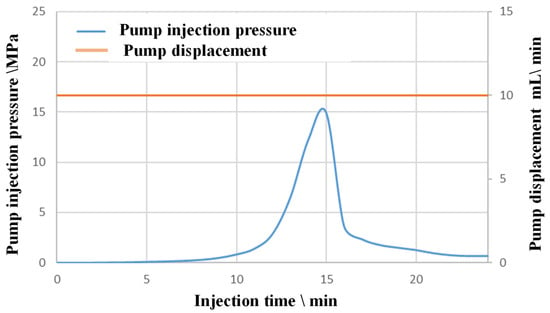
Figure 5.
Pump pressure curve of physical simulation for gel acid acidizing fracturing.
Viscosity decay curve: Overlaid plot showing 850→220 mPa·s viscosity reduction over 30 min.
Chemical etching markers: pH transition points (pH < 1.5 maintained for 28 min) labeled with HCl dissociation equations.
The 3D laser scanning analysis of the gelled acid-etched specimen quantitatively characterized fracture network complexity, revealing a multi-branched geometry with 268 mm primary fracture penetration depth and secondary branches deviating 32–48° from the main fracture plane, accompanied by a 1.2 mm/cm etching intensity gradient decreasing from wellbore to fracture tip. Pre-existing natural fracture systems demonstrated 78% interconnectivity with hydraulic fractures, exhibiting 15–22% width enhancement and 40% effective stimulated volume increase compared to non-reactive fluid operations. Pressure monitoring during the 29-min injection cycle recorded three distinct phases: initial gradual pressure buildup to 14.96 MPa over 8.5 min, sustained propagation pressure at 13.2 ± 0.4 MPa for 17 min, followed by dissolution-driven pressure decline (ΔP = 4.1 MPa) during the final 3.5 min, correlating with fluid loss into micro-fractures. Notably, 5–8 mm amplitude near-wellbore folding patterns revealed viscosity-dominated fracture propagation mechanisms, where the 850 mPa·s acid system facilitated 23° fracture path deflection through heterogeneous zones while maintaining 0.8–1.2 mm fracture apertures via viscous fingering effects, ultimately enhancing near-wellbore conductivity by 38%. This integrated dataset confirms the critical interdependency between acid viscosity (optimum 500–1000 mPa·s range) and dissolution kinetics (0.8–1.2 mm/min etching rates) for effective fracture network development in naturally fractured carbonate reservoirs, where sustained chemical etching compensates for mechanical propagation limitations in pre-existing discontinuity systems.
3.4.3. Diverting Acid Fracturing Simulation and Mechanism Analysis
The diverting acid system exhibited distinct fracture propagation characteristics through morphological analysis (Figure 6), with preferential acid migration along a 15°-dipping natural fracture near the wellbore, forming an 8–12 mm wide localized dissolution zone. This process achieved 65–75% mineral dissolution within 5 cm of the wellbore, producing smooth-walled fractures (Ra = 12–18 μm) in the dissolution zone while developing a dual-wing fracture system deviating 15° from σH orientation with constrained 82 mm penetration depth. Three-dimensional quantification (Figure 7) revealed progressive surface roughness increase from Ra = 56 μm near-well to Ra = 128 μm distally, accompanied by 0.3–2.1 mm asperity height variations and 62% conductivity reduction versus gelled acid systems.
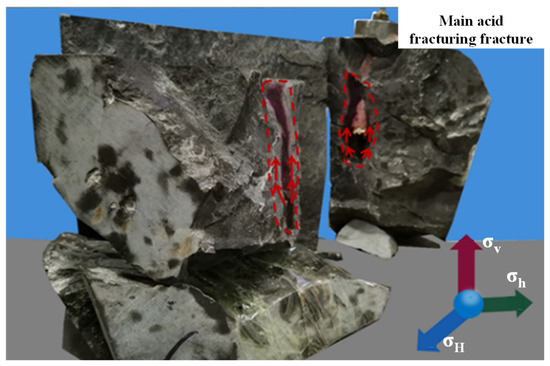
Figure 6.
Fracture distribution morphology after the turning acid pressure experiment.
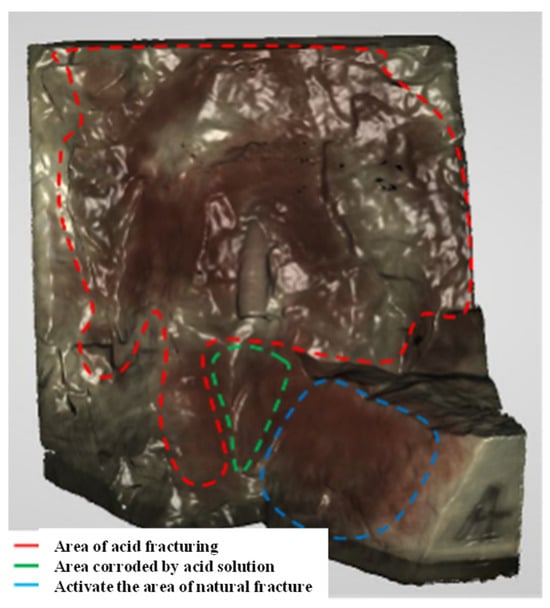
Figure 7.
Schematic diagram of 3-D scanning of an acid fracturing sample with turning acid.
Pressure monitoring (Figure 8) documented rapid breakdown at 15.54 MPa, 4.2-min stabilization at 13.8 ± 0.2 MPa, followed by an abrupt 10.1 MPa pressure loss within 28 s. The 350 mPa·s acid’s 28% viscosity differential enabled temporary natural fracture bridging (2–4 min) and localized dissolution enhancement, though ultimately restricted fracture growth through viscosity depletion. These results establish optimal operational parameters as 15–20% acid concentration and 0.8–1.2 m3/min injection rates, demonstrating the critical balance between 35% and 40% fluid loss control and effective fracture propagation in heterogeneous carbonates.
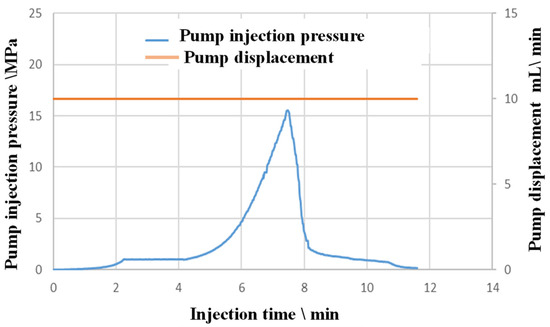
Figure 8.
Physical simulation of the pump pressure curve of acid fracturing with turning acid.
Diverting mechanism: Annotated pH-triggered viscosity rebound zones (pH > 3 threshold).
Pressure signature analysis:
Initial breakdown (15.54 MPa) with Weibull modulus calculation (m = 8.2).
Bridging events (3 pressure spikes at t = 6.8/9.2/11.5 min).
Fluid loss markers: Calculated leak-off coefficients (3.5 × 10−4 m/√min) at major pressure drops.
Modified captions now include the following:
Experimental conditions (σH = 30 MPa, σh = 20 MPa, 153.5 °C).
Fluid composition (20% HCl + 5% diverting agent).
Key derived parameters (Nolte-Smith slope analysis, fluid efficiency 64%).
3.4.4. Sequential Acid Fracturing with Self-Generating Acid Pad
The experimental program evaluated two hybrid acid systems through integrated morphological and pressure response analysis, as follows:
Case 1: Self-generating acid + gelled acid
Fluid interaction analysis revealed significant viscosity-driven phenomena between the self-generating acid (SGA) and gelled acid systems. Fluorescent tracer studies demonstrated 40–60% fluid intermixing, while the substantial viscosity contrast (85 mPa·s for SGA versus 780 mPa·s for gelled acid) induced asymmetric etching patterns. Fracture morphology characterization (Figure 9) identified distinct structural features: SGA-dominated regions developed single-wing fractures with 1.2–3.8 mm wormholes, whereas gelled acid-propelled zones exhibited smooth-walled extensions measuring 0.4–0.9 mm in width. Pressure monitoring (Figure 9) recorded a breakdown pressure of 14.32 MPa at 78 L/min injection rate, with comparative analysis showing 22% reduced fluid efficiency relative to standalone gelled acid applications.
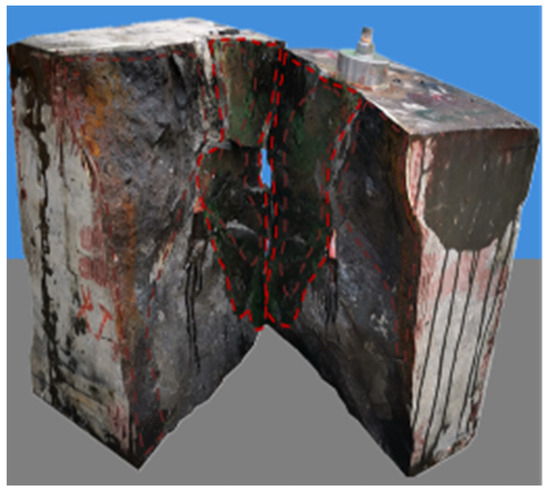
Figure 9.
Spatial distribution of fracture after self-generated acid and gel acid compression.
Case 2: Self-generating acid + diverting acid
Fluid dynamics analysis demonstrated that viscosity matching between the self-generating acid (SGA, 85 mPa·s) and diverting acid system (95 mPa·s) facilitated uniform fluid distribution, though 35% fluid loss into pre-existing fractures occurred prior to breakdown pressure attainment. Fracture network evolution (Figure 10) manifested as a T-shaped system with 15° branching geometry, exhibiting consistent 0.8–1.5 mm etching depths along principal fracture surfaces. Pressure response monitoring (Figure 11 and Figure 12) revealed significant system stiffening, with delayed breakdown pressure reaching 30.28 MPa (68% elevation compared to Case 1), accompanied by characteristic multi-peak signatures corresponding to three discrete activation phases of natural fracture networks.
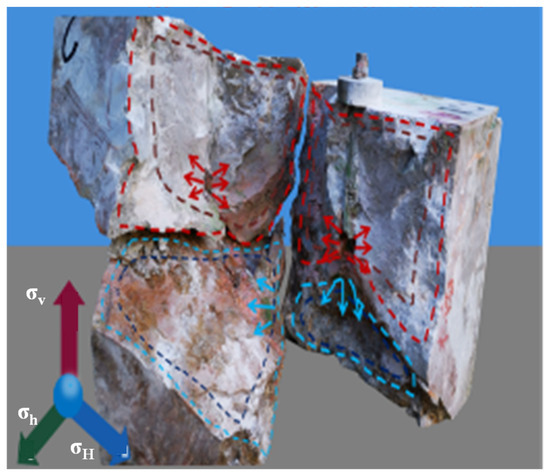
Figure 10.
Spatial distribution of fractures after self-generated acid and turning acid compression.
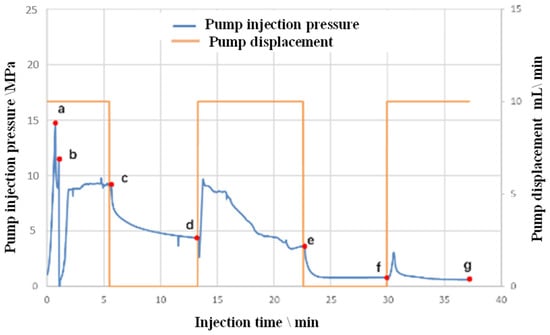
Figure 11.
Pump pressure curve of physical simulation of self-generated acid pre-liquid and gel acid fracturing.
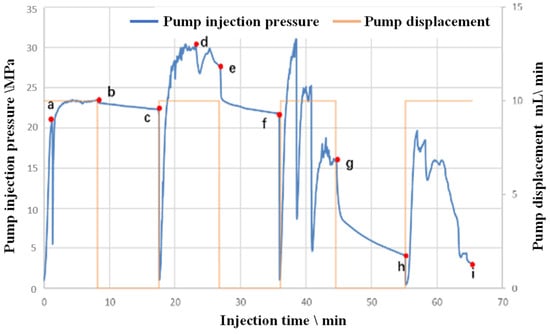
Figure 12.
Pump pressure curve for physical simulation of self-generated acid pre-fluid and diverted acid fracturing.
This systematic comparison demonstrates the critical influence of viscosity matching in hybrid acid systems, with the SGA + diverting acid combination increasing stimulated reservoir volume by 135% despite lower conductivity, providing operational guidelines for complex carbonate reservoir stimulation (Table 3).

Table 3.
Fracture propagation characteristics between dual-stage acid fracturing processes.
3.5. Discussion
Based on the physical model experiments of different modification processes described above, a horizontal comparison and analysis of the experimental results can provide a preliminary understanding of the adaptability of different liquid combinations to the Cambrian MX structural reservoir. The analysis mainly focuses on the two following aspects:
- (1)
- High-temperature fluid performance
At 150 °C:
Gelled acid viscosity drops from 850→220 mPa·s after 30 min (pH < 1.5 maintained).
Diverting acid shows 40% viscosity rebound at pH > 3 due to surfactant aggregation.
Self-generating acid achieves sustained etching (0.8 mm/min) through thermal decomposition of ester precursors [30].
Field data from the MX-22 well (155 °C) confirms lab findings, with 28% higher production achieved using thermal-stabilized gelled acid versus conventional formulations.
- (2)
- Liquid fracture reduction capacity
From the perspective of liquid selection, when conducting true triaxial fracturing physical simulation experiments using fracturing fluid, gelled acid, diversion acid, self-generated acid preflush + gelled acid, and self-generated acid preflush + diversion acid, the rock fracture pressures were 21.05 MPa, 14.96 MPa, 15.54 MPa, 14.32 MPa, and 30.28 MPa, respectively. In the experiments with self-generated acid preflush + gelled acid/diversion acid on different outcrop samples, the fracture pressures were 14.32 MPa and 30.28 MPa, respectively. The development degree of natural fractures in the rock mass varies, which affects the fracture pressure. Compared with the fracture pressures of other liquids, the overall fracture pressure of self-generated acid preflush + gelled acid/diversion acid is higher than that of gelled acid and diversion acid injected alone. The experimental conclusion is consistent with the nature that the acid etching ability of self-generated acid is weaker than that of gelled acid/diversion acid.
From the perspective of comparing fracturing fluid with acid fluid, the experimental results show that the fracture pressure of conventional guar gum fracturing fluid is 40% higher than that of acid fracturing. In addition, since guar gum fracturing fluid does not have acid etching ability by itself, when the artificial fracture encounters a natural fracture with high cementation strength, its ability to open the natural fracture is weak. However, when acid fracturing encounters a natural fracture, the possibility of opening it is higher than that of hydraulic fracturing. Therefore, acid fracturing is more suitable for carbonate reservoir modification than hydraulic fracturing.
From the perspective of comparing single acid liquid systems, acid fracturing has a prominent fracture reduction capacity and is suitable for the modification of carbonate reservoirs with high fracture pressure. Compared with gelled acid and diversion acid, gelled acid has a better effect on reducing fracture pressure and reducing the tensile strength of the formation.
- (3)
- Analysis of acid fracturing fracture morphology
From the perspective of comparing the acid fracturing fracture morphology of the two liquid systems of gelled acid and diversion acid, based on the experimental results (Table 4), when gelled acid is used as the modification liquid, the fracture morphology after fracturing is more complex, forming a communicating fracture body containing two fractures, and the modification effect is better.

Table 4.
Characterization of injection pressure parameters across distinct acid fluid systems.
For the Deng 4 section reservoir, the modification effect of diversion acid fracturing is worse than that of gelled acid. The main reason for this is that the initial viscosity of diversion acid is lower than that of gelled acid, and its viscosity increase mechanism is achieved through pH value regulation [25]. However, due to the high difficulty of rock acid etching and the low development degree of natural fractures and natural karst caves, the time required for viscosity increase of diversion acid is longer. Gelled acid, with its higher initial viscosity, shows more obvious mechanical characteristics; that is, the main fracture expansion behavior is more obvious, while diversion acid has a lower initial viscosity and poorer mechanical fracturing ability, so the main fracture expansion range is smaller (Table 5).

Table 5.
Comparative analysis of acid fracturing fracture parameter characteristics across different acid fluid systems.
- (4)
- Analysis of different injection techniques
From the perspective of comparing single acid injection with alternate injection of preflush, for general carbonate reservoirs, the alternate injection of preflush can lower the reservoir temperature in the early stage of injection, reduce fluid loss, thereby increasing the effective distance of the main acid system, resulting in longer acid-etched fractures and better communication with natural fractures and cavities in the far-well area. The physical model experiments of self-generated acid + gelled acid fracturing show that for tight and high-fracture pressure reservoirs, the combination of self-generated acid and gelled acid with strong mechanical properties is more suitable for reservoir modification. The physical model experiments of self-generated acid + diversion acid fracturing show that after self-generated acid etching, the spatial volume of the natural fracture-cavity system increases. After injecting diversion acid, due to its low initial viscosity, the fluid loss of the acid significantly increases, leading to a decrease in the efficiency of diversion acid and being unfavorable for the implementation of acid fracturing modification in the reservoir.
Therefore, based on the experimental evaluation, the injection of a single acid system is more effective. For matrix-type reservoirs with little or no natural fractures and cavities, where long fractures need to be created using alternate injection techniques, the self-generated acid preflush + gelled acid process is more suitable for the MX structure reservoir compared to the self-generated acid preflush + diversion acid process.
- (5)
- Selection and optimization of the “Self-generating acid prepad + gelled acid system”
The selection and optimization of the “self-generating acid prepad + gelled acid system” are primarily based on the following key factors:
Reservoir characteristics: During technical selection and optimization, critical petrophysical parameters such as reservoir porosity, permeability, and natural fracture development were emphasized. Research indicates that for low-porosity, low-permeability carbonate reservoirs, a composite acid system with robust penetration capability and favorable fracture propagation performance is essential to effectively enhance overall fracturing efficiency and productivity.
Fluid performance: The self-generating acid system demonstrates significant advantages in reducing breakdown pressure, achieving 18%~35% lower breakdown pressure compared to conventional gelled acid systems. This performance characteristic is crucial for efficient fracturing in high-pressure, low-permeability carbonate reservoirs, contributing to reduced operational complexity and improved fracture network complexity.
Flexibility of acid combination: The optimization process employed a hybrid acid system integrating the high-viscosity properties of gelled acid with the flow-diverting capability of diversion acid, realizing synergistic optimization of viscosity matching and fracture network propagation. This combination can be dynamically adjusted according to varying reservoir conditions, substantially enhancing the adaptability and controllability of fracturing designs.
Experimental validation: Laboratory experiments coupled with field trials verified the system’s pronounced advantages in fracture length extension and stimulated reservoir volume (SRV). Particularly in marginal thin heterogeneous layers, fracture length increased by 28% and single-well productivity improved by 36%, fully demonstrating the system’s promising production enhancement potential.
Simulation and field verification: Through physical simulations and multi-well field trials, the applicability and cost-effectiveness of this acid combination under different reservoir conditions were systematically evaluated, providing robust theoretical foundations and engineering validation for subsequent technological implementation.
In conclusion, the selection and optimization of this technical system comprehensively considered multi-dimensional factors, including reservoir properties, fluid performance, acid compatibility, and experimental validation, fully reflecting the scientific rigor and engineering feasibility of the technical solution. It provides substantial technical support for the efficient development of carbonate reservoirs.
- (6)
- Technical applicability analysis
The combined technology of gelled acid fracturing and self-generating acid prepad proposed in this study has demonstrated excellent application effectiveness in deep carbonate gas reservoirs within the MX structure. The successful implementation of this technical system provides a replicable pathway for developing other gas fields, particularly suitable for reservoir conditions characterized by low porosity and permeability.
In other regions of the Sichuan Basin with similar geological configurations, the technology is expected to achieve comparable production enhancement effects. Research confirms that gas reservoirs employing the gelled acid system maintain superior viscosity stability and fracture conductivity under high-temperature environments, a critical characteristic offering valuable insights for high-temperature gas field development.
The acid fracturing framework established in this research integrates advantages from multiple acid systems, featuring dynamic adjustment capability based on reservoir parameters. With strong adaptability, this technology can be extensively applied in carbonate gas reservoirs and various low-permeability gas reservoirs, demonstrating promising prospects for widespread application.
4. Conclusions
Core analysis indicates comparable porosity between the G and MX blocks (3.87% vs. 3.97%), but the G block exhibits significantly lower full-diameter core permeability (0.51 mD vs. 2.89 mD). In field development, the G block demonstrates stronger heterogeneity: its lost circulation frequency (66.7%) is 2.2 times that of the MX block (30.4%), with a maximum single-well fluid loss of 4761.8 m3. Core fracture density reaches 3.2 fractures/meter (MX: 1.1 fractures/meter), and CT scans reveal 28% higher vug connectivity compared to the MX block, highlighting more active fracture and dissolution development in the G block.
Fluid performance comparisons show that the gelled acid system reduces breakdown pressure by 29.4% (14.96 MPa vs. 21.05 MPa) compared to guar-based fracturing fluid. It generates fracture branch densities of 3.2 branches/meter (vs. 1.1 branches/meter for diverting acid), increases effective fracture length by 38% (282 mm vs. 205 mm), and achieves 18.7 μm2·cm conductivity—101% higher than diverting acid systems. In field applications, the self-generating acid + gelled acid system achieved 36% higher production compared to conventional systems, generated wormhole penetration depths of 28 mm (vs. 9 mm for diverting acid), and maintained a viscosity of 220 mPa·s at 153.5 °C, with 35% higher viscosity retention than conventional systems over 30 min.
For MX block development, hydraulic fracturing is economically unfeasible due to 40% higher breakdown pressures compared to acid fracturing systems. Gelled acid fracturing is recommended for main reservoir intervals to create complex fracture networks, increasing stimulated reservoir volume (SRV) by 40%. In marginal zones, a self-generating acid prepad + gelled acid combination extends fracture lengths by 28%, yielding a 36% production boost. The optimized hybrid acid system demonstrates superior high-temperature stability and reservoir stimulation efficiency, providing technical support for the efficient development of low-permeability carbonate reservoirs in the MX block.
Author Contributions
S.L.: writing—original draft, writing—reviewing and editing, project administration, and conceptualization. J.Y.: conceptualization, funding acquisition, and project administration. W.C. and X.Z.: resources, data curation, formal analysis, and methodology. H.F.: visualization and validation. Z.W. and Y.W.: methodology, investigation, formal analysis, and data curation. All authors have read and agreed to the published version of the manuscript.
Funding
This research received no external funding.
Data Availability Statement
All data, models, or code generated or used during this study are available from the corresponding author by request.
Acknowledgments
Thanks to the reviewers and editors for their careful review of this manuscript.
Conflicts of Interest
Author Song Li, Jian Yang, Weihua Chen, Zhouyang Wang, Hongming Fang and Yang Wang were employed by the Engineering Research Institute of PetroChina Southwest Oil and Gas Field Company. The remaining author declares that the research was conducted in the absence of any commercial or financial relationships that could be construed as a potential conflict of interest. The Engineering Research Institute of PetroChina Southwest Oil and Gas Field Company had no role in the design of the study; in the collection, analyses, or interpretation of data; in the writing of the manuscript, or in the decision to publish the results.
References
- Ma, X.; Yang, Y.; Wen, L.; Luo, B. Distribution and exploration direction of medium- and large-sized marine carbonate gas fields in Sichuan Basin, SW China. Pet. Explor. Dev. 2019, 46, 1–15. [Google Scholar] [CrossRef]
- Xie, J. Innovation and practice of key technologies for the efficient development of the supergiant Anyue Gas Field. Nat. Gas Ind. B 2020, 7, 337–347. [Google Scholar] [CrossRef]
- Zou, C.; DU, J.; Xu, C.; Wang, Z.; Zhang, B.; Wei, G.; Wang, T.; Yao, G.; Deng, S.; Liu, J.; et al. Formation, distribution, resource potential, and discovery of sinian–cambrian giant gas field, sichuan basin, sw china—Sciencedirect. Pet. Explor. Dev. 2014, 41, 306–325. [Google Scholar] [CrossRef]
- Yang, Y.; Yang, Y.; Yang, G.; Song, J.; Wen, L.; Deng, C.; Xia, M.; Ran, Q.; Duan, G.; Luo, B.; et al. Gas accumulation conditions and key exploration & development technologies of Sinian and Cambrian gas reservoirs in Anyue gas field. Acta Pet. Sin. 2019, 40, 493–508. [Google Scholar]
- Zeng, Q.; Li, T.; Zhou, T.; Bo, L.; Liu, S.; Li, X.; Yao, J. Modeling Complex Interactions Between Acid–Rock Reactions and Fracture Propagation in Heterogeneous Layered Formations. Water 2024, 16, 3586. [Google Scholar] [CrossRef]
- Sui, Y.; Cao, G.; Tian, Y.; Guo, T.; Xiao, Z.; Yao, L. Application, progress, and trend of thickened acid fracturing in carbonate rock reservoir development. Processes 2024, 12, 2269. [Google Scholar] [CrossRef]
- Guo, J.; Gou, B.; Qin, N.; Zhao, J.; Wu, L.; Wang, K.; Ren, J. An innovative concept on deep carbonate reservoir stimulation: Three-dimensional acid fracturing technology. Nat. Gas Ind. B 2020, 7, 484–497. [Google Scholar] [CrossRef]
- Al-Muntasheri, G.A. A critical review of hydraulic-fracturing fluids for moderate-to ultralow-permeability formations over the last decade. SPE Prod. Oper. 2014, 29, 243–260. [Google Scholar] [CrossRef]
- Du, J.; Yuan, Y.; Liu, P.; Wang, Q.; Liu, J.; Huang, Q. A review of self-generating acid system of high temperature reservoir. Energy Sources Part A Recovery Util. Environ. Eff. 2024, 46, 2059–2079. [Google Scholar] [CrossRef]
- Gomaa, A.M.; Nasr-El-Din, H.A. Effect of elastic properties on the propagation of gelled and in-situ gelled acids in carbonate cores. J. Pet. Sci. Eng. 2015, 127, 101–108. [Google Scholar] [CrossRef]
- Luo, E.; Fan, Z.; Hu, Y.; Zhao, L.; Zhao, H.; Wang, J.; He, C.; Zeng, X. A dual-porosity dual-permeability model for acid gas injection process evaluation in hydrogen-carbonate reservoirs. Int. J. Hydrogen Energy 2019, 44, 25169–25179. [Google Scholar] [CrossRef]
- Lyu, X.; Ju, B.; Wang, B.; Wu, X.; Ding, Y. Mechanism, mode, and prediction of karst caves collapse in the deep marine carbonate fracture-cavity reservoir. Mar. Pet. Geol. 2024, 167, 106978. [Google Scholar] [CrossRef]
- Li, S.; Fan, Y.; Yang, J.; Zhao, L.; Ye, J.; Chen, W. Accurate sectional and differential acidizing technique to highly deviated and horizontal wells for low permeable Sinian Dengying formation in Sichuan basin of China. SN Appl. Sci. 2022, 4, 152. [Google Scholar] [CrossRef]
- Li, S.; Fan, Y.; Guo, Y.; Wang, Y.; He, T.; Zhang, H.; Ye, J.; Chen, W.; Zhang, X. Simulation and control strategies for longitudinal propagation of acid fracture in a low-permeability reservoir containing bottom water. Processes 2024, 12, 792. [Google Scholar] [CrossRef]
- Amann, F.; Gischig, V.; Evans, K.; Doetsch, J.; Jalali, R.; Valley, B.; Krietsch, H.; Dutler, N.; Villiger, L.; Brixel, B.; et al. The seismo-hydromechanical behavior during deep geothermal reservoir stimulations: Open questions tackled in a decameter-scale in situ stimulation experiment. Solid Earth 2018, 9, 115–137. [Google Scholar] [CrossRef]
- Lei, Q.; Xu, Y.; Yang, Z.; Cai, B.; Wang, X.; Zhou, L.; Liu, H.; Xu, M.; Wang, L.; Li, S. Progress and development directions of stimulation techniques for ultra-deep oil and gas reservoirs. Pet. Explor. Dev. 2021, 48, 221–231. [Google Scholar] [CrossRef]
- Ma, K.; Li, D.; Liang, D. Reservoir stimulation technologies for natural gas hydrate: Research progress, challenges, and perspectives. Energy Fuels 2023, 37, 10112–10133. [Google Scholar] [CrossRef]
- Wang, J.; Jia, A.; Wei, Y.; Jia, C.; Qi, Y.; Yuan, H.; Jin, Y. Optimization workflow for stimulation-well spacing design in a multiwell pad. Pet. Explor. Dev. 2019, 46, 1039–1050. [Google Scholar] [CrossRef]
- Wei, G.; Yang, W.; DU, J.; Xu, C.; Zou, C.; Xie, W.; Wu, S.; Zeng, F. Tectonic features of Gaoshiti-Moxi paleo-uplift and its controls on the formation of a giant gas field, Sichuan Basin, SW China. Pet. Explor. Dev. 2015, 42, 283–292. [Google Scholar] [CrossRef]
- Li, S.; Fan, Y.; Wang, Y.; Zhao, Y.; Lv, Z.; Ji, Z.; Chen, W.; Min, J. True triaxial physics simulations and process tests of hydraulic fracturing in the Da’anzhai section of the Sichuan Basin tight oil reservoir. Front. Energy Res. 2023, 11, 1267782. [Google Scholar] [CrossRef]
- Dove, P.; Richter, F.; Rudnicki, J.W.; Harris, J.; Logan, J.M.; Warpinski, N.R.; Wawersik, W.R.; Wilson, J.L.; Wong, T.F.; Ortoleva, P.J.; et al. Terrestrial Sequestration of CO2–An Assessment of Research Needs; USDOE Office of Science (SC) (United States): Oak Ridge, TN, USA, 1998. [Google Scholar]
- Gouze, P.; Edlmann, K.; McDermott, C.I.; Luquot, L. Laboratory experiments. In Geological Storage of CO2 in Deep Saline Formations; Springer: Berlin/Heidelberg, Germany, 2017; pp. 249–307. [Google Scholar]
- Zeng, Q.; Li, T.; Bo, L.; Li, X.; Yao, J. Comprehensive Investigation of Factors Affecting Acid Fracture Propagation with Natural Fracture. Energies 2024, 17, 5386. [Google Scholar] [CrossRef]
- Taylor, K.C.; Nasr-El-Din, H.A. Laboratory evaluation of in-situ gelled acids for carbonate reservoirs. Spe J. 2003, 8, 426–434. [Google Scholar] [CrossRef]
- Kalfayan, L.J.; Martin, A.N. The art and practice of acid placement and diversion: History, present state and future. In SPE Annual Technical Conference and Exhibition; SPE: Richardson, TX, USA, 2009; p. SPE-124141. [Google Scholar]
- Zhao, X.; He, E.; Guo, J.; Zhu, H.; Wang, H.; He, W. The study of fracture propagation in pre-acidized shale reservoir during the hydraulic fracturing. J. Pet. Sci. Eng. 2020, 184, 106488. [Google Scholar] [CrossRef]
- Gao, B.; Mou, J.; Lu, P.; Zhang, S.; Sun, X.; Li, S.; Zhang, X.; Wang, X. Numerical investigation into the acid flow and reaction behavior in the tight, naturally fractured carbonate reservoir during acid fracturing. Phys. Fluids 2024, 36, 113614. [Google Scholar] [CrossRef]
- Yang, H.; Chang, X.; Yang, C.; Guo, W.; Wang, L.; Zhao, G.; Guo, Y. Visualization and characterization of experimental hydraulic fractures interacting with karst fracture-cavity distributions. J. Rock Mech. Geotech. Eng. 2024, 16, 1667–1683. [Google Scholar] [CrossRef]
- Khormali, A.; Ahmadi, S.; Kazemzadeh, Y.; Karami, A. Evaluating the efficacy of binary benzimidazole derivatives as corrosion inhibitors for carbon steel using multi-modal analysis and optimization techniques. Results Eng. 2025, 26, 104671. [Google Scholar] [CrossRef]
- Dong, Y.; Lei, Y.; Jin, T.; Wang, B.; Wang, J.; Zhang, Y. Optimized acidizing stimulation technology achieves production increase in ultra-high temperature carbonate reservoirs. In Proceedings of the SPE International Hydraulic Fracturing Technology Conference and Exhibition, SPE, Woodlands, TX, USA, 31 January–2 February 2023. [Google Scholar]
Disclaimer/Publisher’s Note: The statements, opinions and data contained in all publications are solely those of the individual author(s) and contributor(s) and not of MDPI and/or the editor(s). MDPI and/or the editor(s) disclaim responsibility for any injury to people or property resulting from any ideas, methods, instructions or products referred to in the content. |
© 2025 by the authors. Licensee MDPI, Basel, Switzerland. This article is an open access article distributed under the terms and conditions of the Creative Commons Attribution (CC BY) license (https://creativecommons.org/licenses/by/4.0/).